The preferred Elliott wave count expected price to continue lower, which is exactly what has happened. A channel was used on the hourly chart to indicate where bounces may find resistance, and this has almost perfectly shown where the high for the session ended before price turned to move strongly lower.
Summary: Both a Shooting Star on the weekly chart and an Evening Star on the daily chart indicate a high may be in place. Next, a close below support at 1,300 and a breach of the blue channel on the daily chart are required for confidence in the preferred Elliott wave count.
Expect downwards movement to continue. Use the channel on the hourly chart to indicate were bounces may find resistance.
New updates to this analysis are in bold.
Grand SuperCycle analysis is here.
Last historic analysis with monthly charts is here.
MAIN ELLIOTT WAVE COUNT
WEEKLY CHART – TRIANGLE
This is the preferred wave count.
Cycle wave b may be a complete regular contracting triangle. If it continues further, then primary wave E may not move beyond the end of primary wave C above 1,365.68.
Four of the five sub-waves of a triangle must be zigzags, with only one sub-wave allowed to be a multiple zigzag. Wave C is the most common sub-wave to subdivide as a multiple, and this is how primary wave C for this example fits best.
There are no problems in terms of subdivisions or rare structures for this wave count. It has an excellent fit and so far a typical look.
This wave count would expect a cycle degree trend change has just occurred. Cycle wave c would most likely make new lows below the end of cycle wave a at 1,046.27 to avoid a truncation.
Primary wave E should exhibit reasonable weakness as it comes to an end. Triangles often end with declining ATR, weak momentum and weak volume.
If this weekly wave count is correct, then cycle wave c downwards should develop strength, ATR should show some increase, and MACD should exhibit an increase in downwards momentum.
DAILY CHART – TRIANGLE
Primary wave E should subdivide as a zigzag. Intermediate waves (A) and (B) may now be complete. Intermediate wave (C) may again be complete, and there is some indication of a high in place.
This wave count now expects that a trend change has occurred at the last high. The remaining two things are now required for confidence in this wave count:
1. A new low below support at 1,300.
2. A breach of the blue Elliott channel.
HOURLY CHART
Minute waves i and ii may be complete. This hourly chart shows all of minute wave iii so far, from its start as labelled on the daily chart.
At 1,295 minute wave iii would reach 1.618 the length of minute wave i.
Minute wave iii may only subdivide as an impulse, and within it minuette waves (i) and (ii) may be complete.
Minuette wave (iii) may only subdivide as an impulse, and within it subminuette waves i and ii may be complete.
Subminuette wave iii may only subdivide as an impulse, and within it micro waves 1 and 2 may be complete. Within micro wave 3, no second wave correction may move beyond the start of its first wave above 1,326.70.
A best fit channel is drawn about this downwards movement to contain all of it. The first trend line is drawn from the start of minute wave i to the high labelled subminuette wave ii. A parallel copy is placed on the swing low just prior to the end of minute wave i. The upper edge may show where bounces may find resistance. The middle to end of a third wave may have the power to break below support at the lower edge.
WEEKLY CHART – DOUBLE ZIGZAG
It is possible that cycle wave b may be a double zigzag or a double combination.
The first zigzag in the double is labelled primary wave W. This has a good fit.
The double may be joined by a corrective structure in the opposite direction, a triangle labelled primary wave X. The triangle would be about four fifths complete.
Within multiples, X waves are almost always zigzags and rarely triangles. Within the possible triangle of primary wave X, it is intermediate wave (B) that is a multiple; this is acceptable, but note this is not the most common triangle sub-wave to subdivide as a multiple. These two points reduce the probability of this wave count.
Intermediate wave (D) may be complete. The (B)-(D) trend line is almost perfectly adhered to with the smallest overshoot within intermediate wave (C). This is acceptable.
Intermediate wave (E) should continue to exhibit weakness: ATR should continue to show a steady decline, and MACD may begin to hover about zero.
Intermediate wave (E) may not move beyond the end of intermediate wave (C) below 1,160.75.
This wave count may now expect downwards movement for several weeks.
Primary wave Y would most likely be a zigzag because primary wave X would be shallow; double zigzags normally have relatively shallow X waves.
Primary wave Y may also be a flat correction if cycle wave b is a double combination, but combinations normally have deep X waves. This would be less likely.
This wave count has good proportions and no problems in terms of subdivisions.
WEEKLY CHART – ALTERNATE BULLISH
Because the preferred wave count is at a critical juncture in expecting a cycle degree trend change, it is time to consider an alternate which expects the continuation of the an upwards trend.
It is possible that the low in December 2015 was the end of a bear market and that Gold has been in a basing action for the past three years. Downwards movement to that low will subdivide as a double zigzag, a corrective structure.
If Gold is in a new bull market, then it should begin with a five wave structure upwards on the weekly chart. However, the biggest problem with this wave count is the structure labelled cycle wave I because this wave count must see it as a five wave structure, but it looks more like a three wave structure.
Commodities often exhibit swift strong fifth waves that force the fourth wave corrections coming just prior to be more brief and shallow than their counterpart second waves. It is unusual for a commodity to exhibit a quick second wave and a more time consuming fourth wave, and this is how cycle wave I is labelled. The probability of this wave count is low due to this problem.
Cycle wave II subdivides well as a double combination: zigzag – X – expanded flat.
Cycle wave III may have begun. Within cycle wave III, primary wave 1 may now be complete. The target for primary wave 2 is the 0.618 Fibonacci ratio of primary wave 1. Primary wave 2 may not move beyond the start of primary wave 1 below 1,160.75.
A black channel is drawn about primary wave 1. Primary wave 2 may breach the lower edge of this channel.
Cycle wave III so far for this wave count would have been underway now for 27 weeks. It should be beginning to exhibit some support from volume, increase in upwards momentum and increasing ATR. However, volume continues to decline, ATR continues to decline and is very low, and momentum is weak in comparison to cycle wave I. This wave count lacks support from classic technical analysis.
TECHNICAL ANALYSIS
WEEKLY CHART
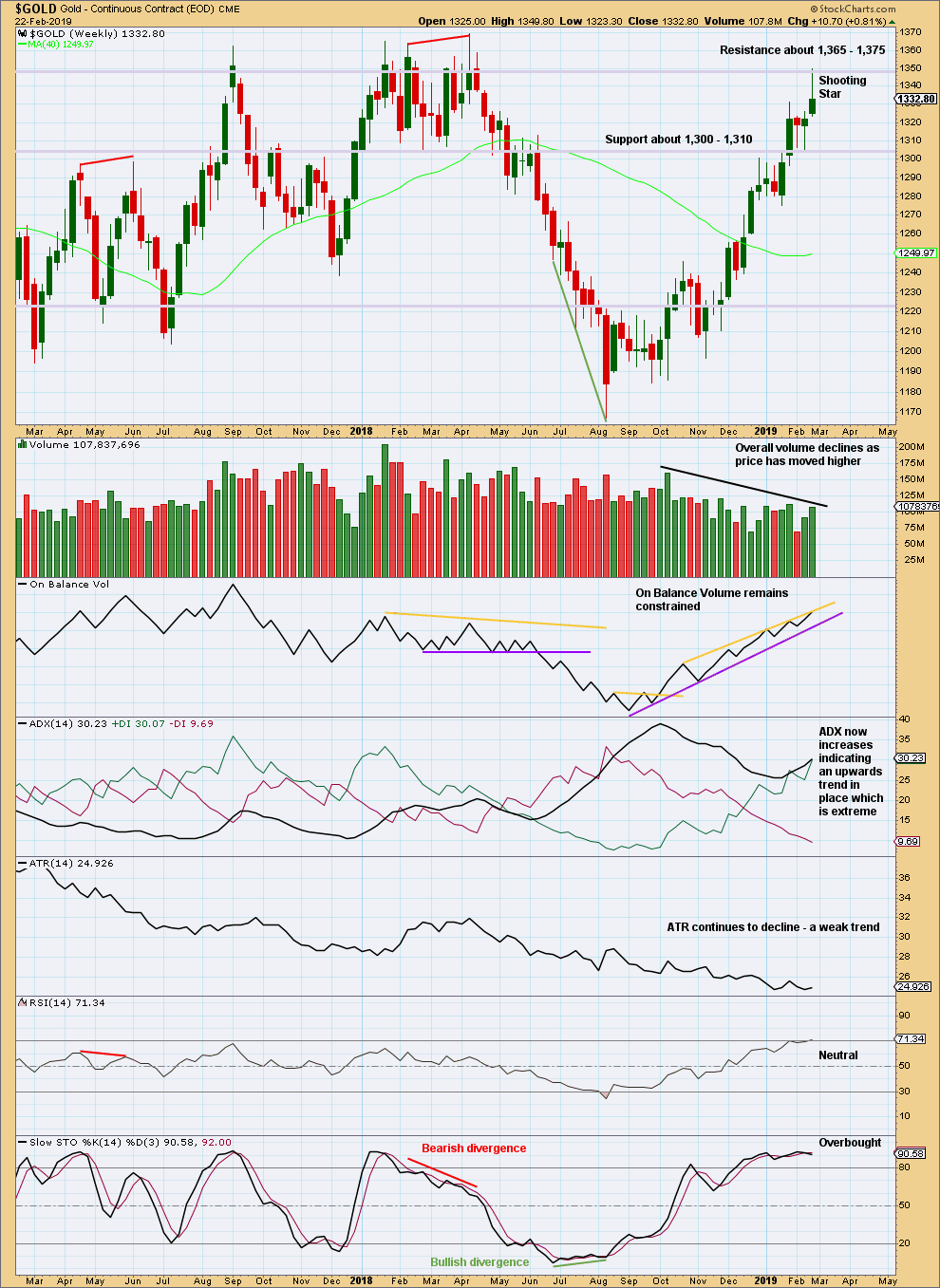
Click chart to enlarge. Chart courtesy of StockCharts.com.
Last week’s upper candlestick wick is 2.18 times the length of the real body. This fits the requirements for a star pattern (the wick needs to be a minimum of twice the length of the real body). Shooting Star candlestick patterns appearing within an upwards trend are bearish reversal patterns.
The longer-term volume profile is bearish, but the short-term volume profile is bullish. On balance my judgement is that the volume profile is more bearish than bullish.
This chart warns that a high may be in place.
DAILY CHART
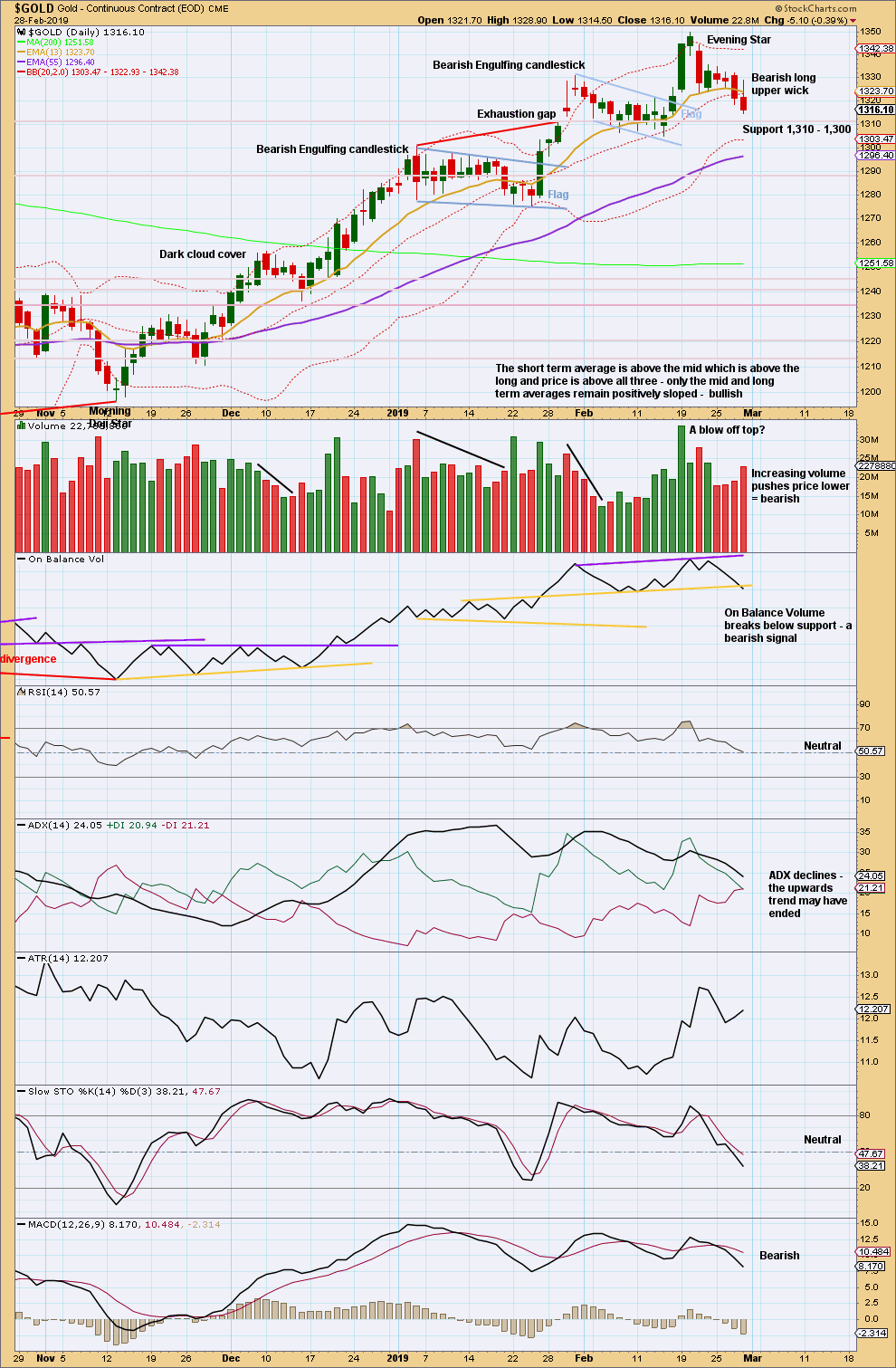
Click chart to enlarge. Chart courtesy of StockCharts.com.
The Evening Star reversal pattern indicates a trend change here to either down or sideways.
The short-term volume profile is bearish. ADX suggests the upwards trend may be over. This chart offers some support to the Elliott wave analysis.
Price is now very close to support.
Today On Balance Volume has broken below its support line. This bearish signal coming before price breaks below support indicates price may follow shortly. This supports the Elliott wave analysis.
GDX WEEKLY CHART
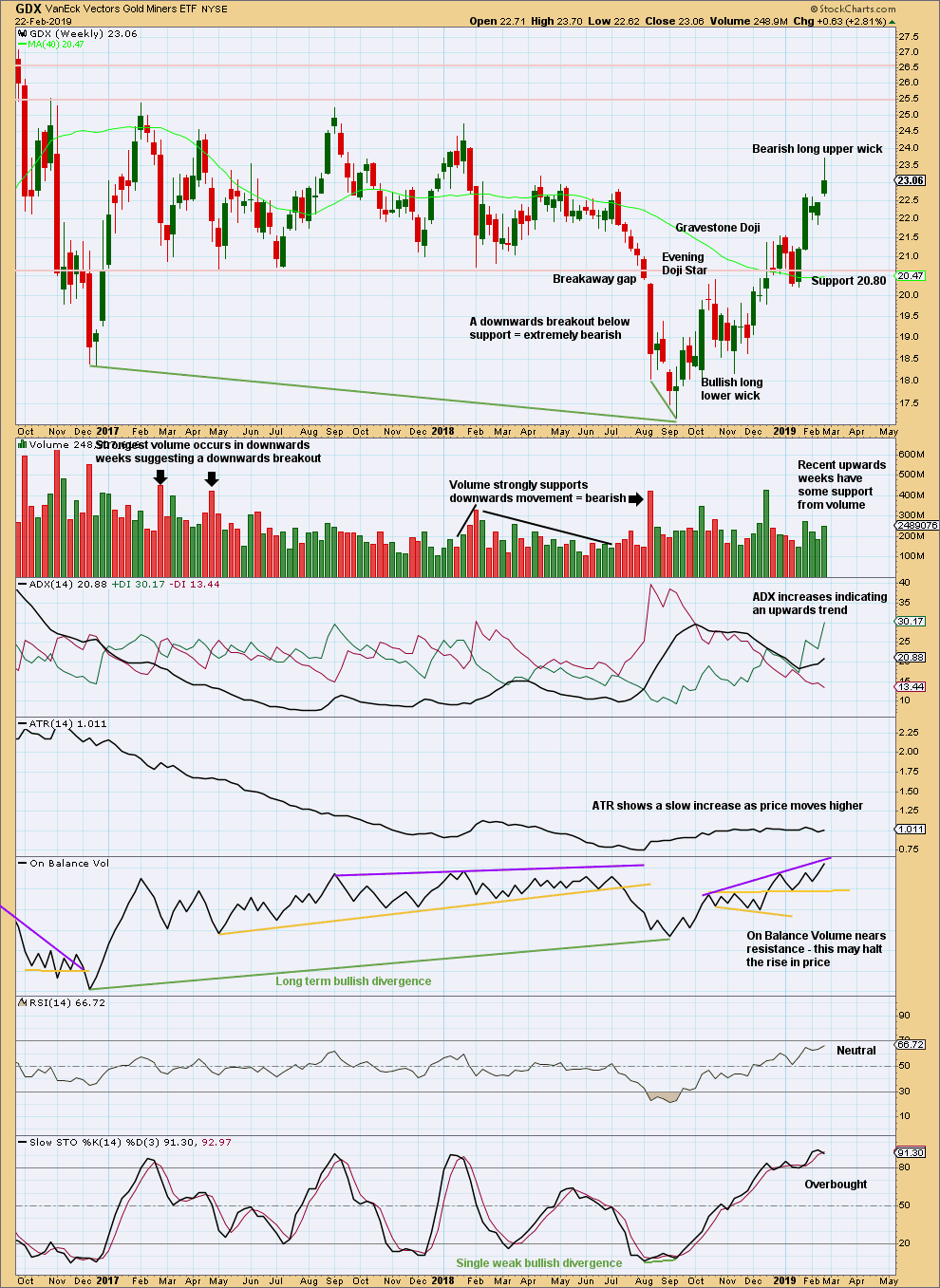
Click chart to enlarge. Chart courtesy of StockCharts.com.
Last week’s candlestick for GDX is not a Shooting Star pattern. The upper wick at 1.83 times the real body is less than the required length of 2. However, the long upper wick still carries a bearish implication.
At this time frame there is as yet no evidence this trend is over. This view may be held while the last gap remains open if price does not make a new low below 22.44.
GDX DAILY CHART
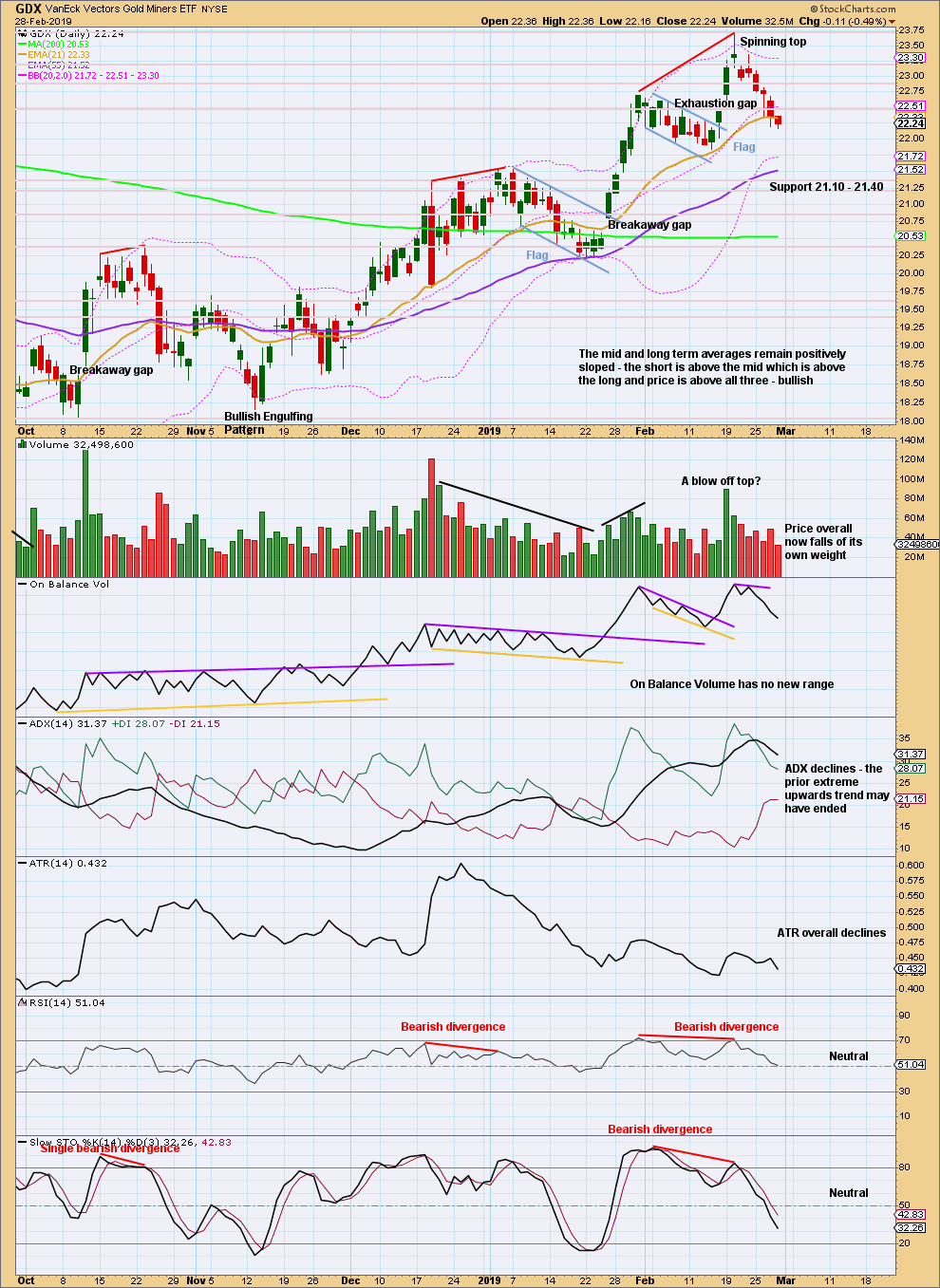
Click chart to enlarge. Chart courtesy of StockCharts.com.
The last gap is closed, and it is relabelled an exhaustion gap. Expect more downwards movement as most likely here from GDX.
Look for next support about 21.40 to 21.10.
Published @ 06:53 p.m. EST.
—
Careful risk management protects your trading account(s).
Follow my two Golden Rules:
1. Always trade with stops.
2. Risk only 1-5% of equity on any one trade.

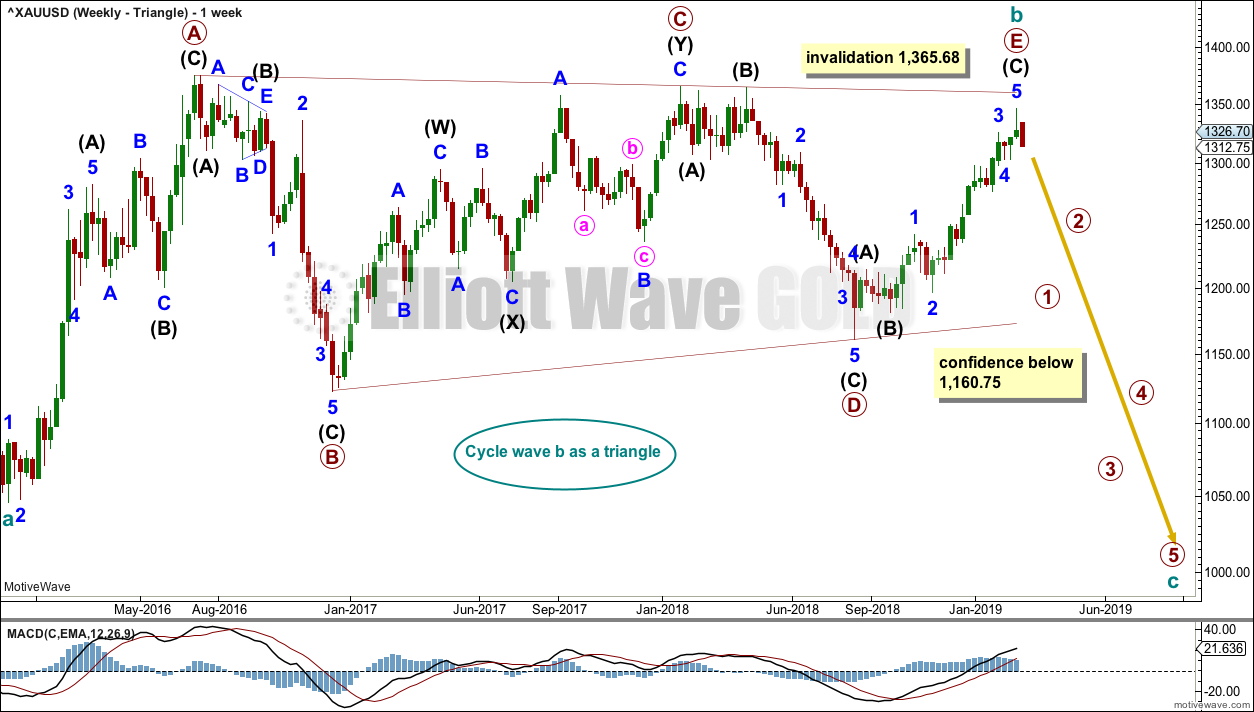
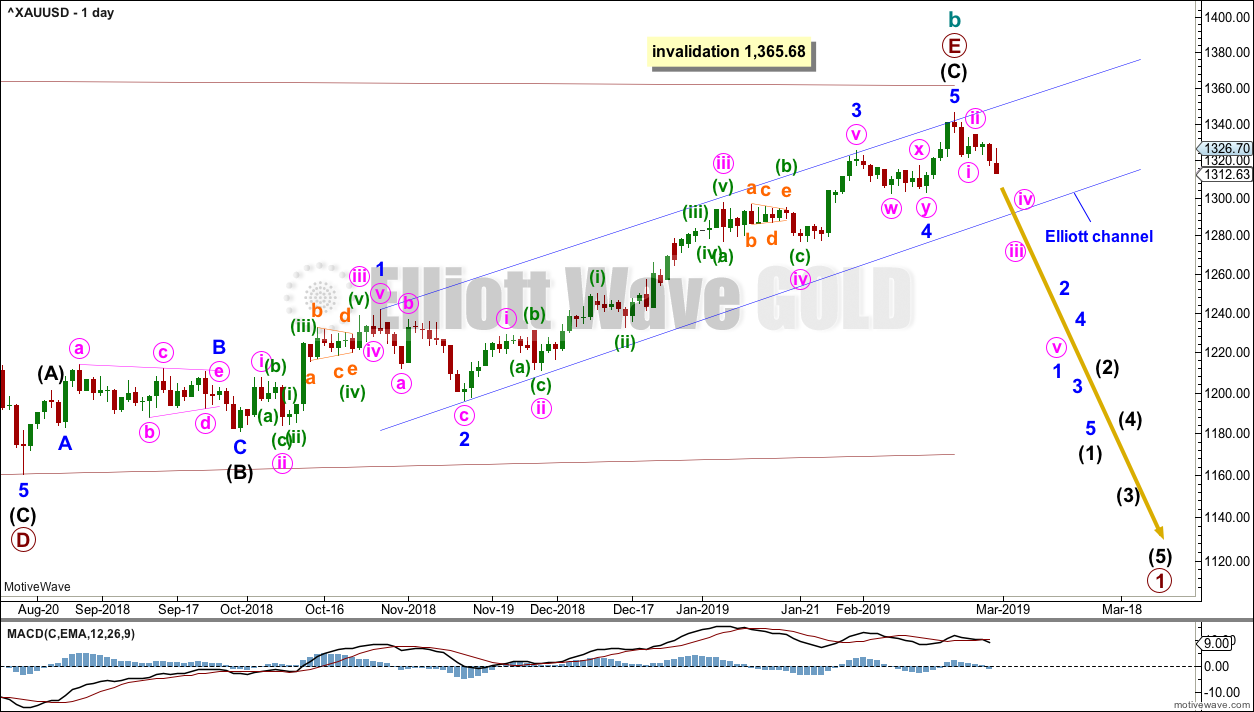
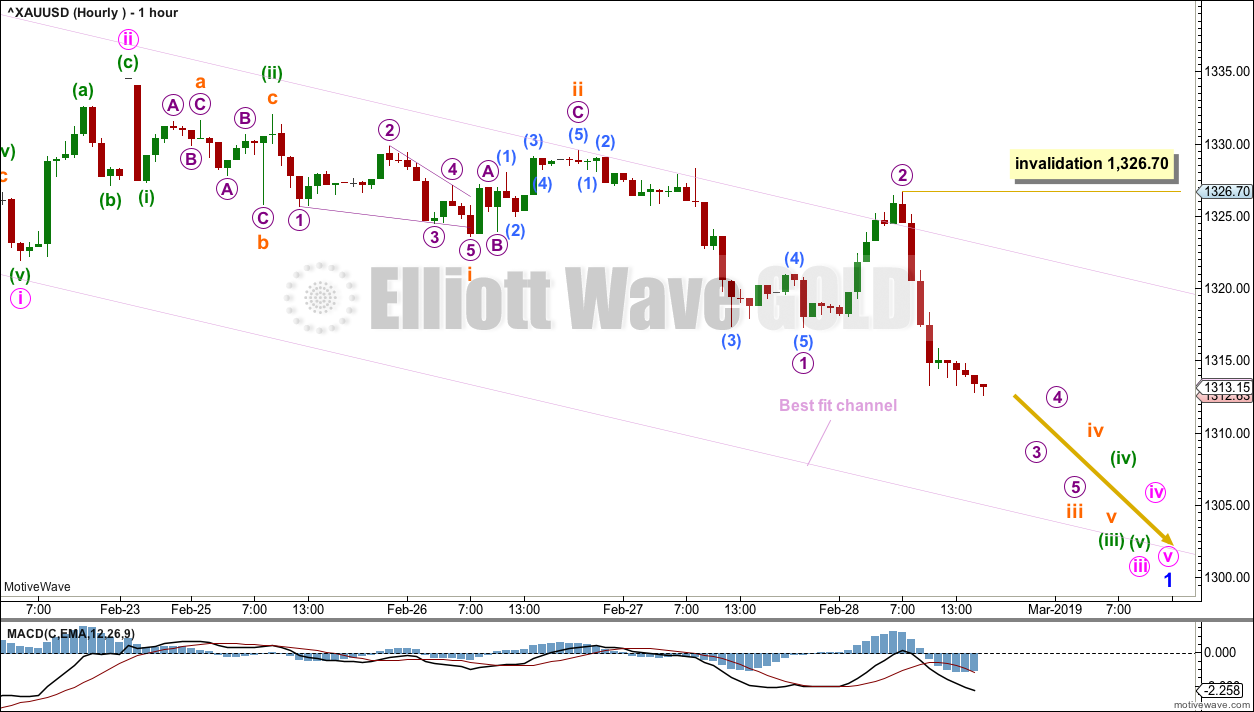
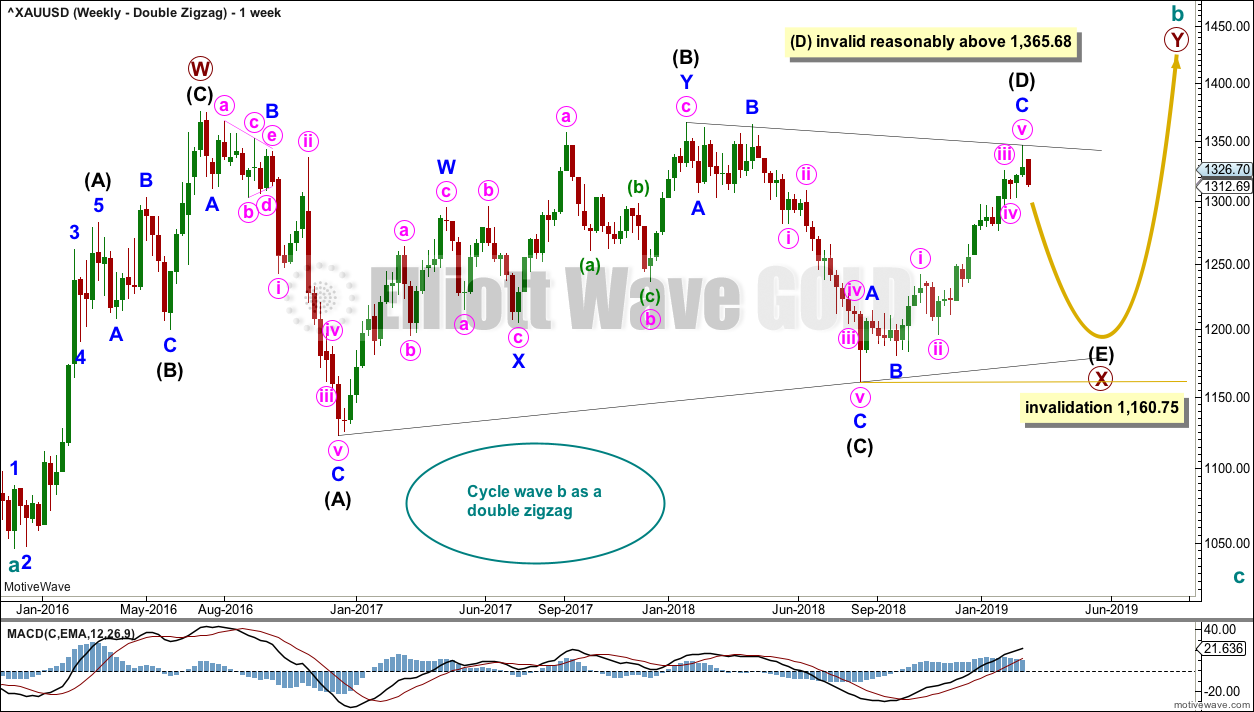

Hourly chart updated:
Price is now very close to the lower edge of the blue channel. It may bounce a little there, or it may slice through. If it slices through then look for a quick bounce to test resistance from the under side.
The trend is clearly down. Use bounces as opportunities to join the trend, and manage risk by always following my two risk management rules.